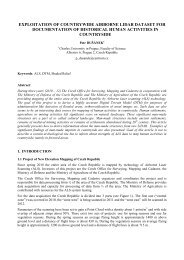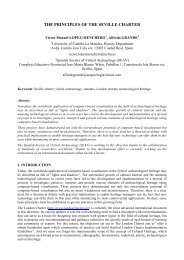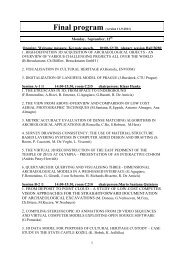Information management systems for cultural ... - CIPA - Icomos
Information management systems for cultural ... - CIPA - Icomos
Information management systems for cultural ... - CIPA - Icomos
You also want an ePaper? Increase the reach of your titles
YUMPU automatically turns print PDFs into web optimized ePapers that Google loves.
World Heritage properties are confronted to a number of threats due to e.g. tourism, development,<br />
deterioration processes and climate change. Adequate monitoring of <strong>management</strong> measures should be<br />
proposed and include tracking physical changes of the monuments, controlling visitors’ carrying capacity,<br />
and clearly defining the boundaries and buffer zones among other activities. Several charters and<br />
international conventions such as the World Heritage Convention, the Venice Charter, the Burra Charter and<br />
many others aim to guide site managers and protect these sites. However, when looking at serial<br />
transnational nominations, the issues mentioned be<strong>for</strong>e become more complex and require better<br />
coordination and more collaboration among State Parties. There<strong>for</strong>e, the different stakeholders involved in<br />
World Heritage nominations need to find a way to improve collaboration and better understand their heritage<br />
places by easily mining, sharing and exchanging in<strong>for</strong>mation from multiple sources using common<br />
standards.<br />
Following UNESCO’s recommendations [7] in the use of digital technology, the application of IMS in<br />
<strong>cultural</strong> heritage is a cost-effective tool to easily understand, store, share, manage and monitor serial<br />
transnational World Heritage nominations. An IMS is able to support these kinds of nominations in the<br />
conservation and monitoring processes by defining standards, storing large data volume and acting as a<br />
collaborative plat<strong>for</strong>m <strong>for</strong> the State Parties to share in<strong>for</strong>mation and take in<strong>for</strong>med decisions. The case study<br />
of the Silk Roads Cultural Heritage Resource <strong>In<strong>for</strong>mation</strong> Management System (CHRIS) will illustrate the<br />
implementation of IMS on the elaboration of World Heritage nomination dossiers.<br />
1.1. Serial transnational World Heritage nominations<br />
A major purpose of the World Heritage Convention is to foster international cooperation <strong>for</strong> the protection<br />
and <strong>management</strong> of the outstanding <strong>cultural</strong> and natural heritage sites. The concept of serial nominations is<br />
an innovative approach supporting this aim. Serial nominations are submitted as single properties with one<br />
Outstanding Universal Value, and their nomination, monitoring and <strong>management</strong> must be treated as such [1].<br />
Within this category and looking <strong>for</strong>ward to a more representative, balanced and credible World Heritage<br />
List, serial transnational nominations are an opportunity to encourage collaboration and exchange between<br />
State Parties. However, these nominations come together with more complex challenges specifically in the<br />
systematization and <strong>management</strong> of the in<strong>for</strong>mation.<br />
UNESCO World Heritage Centre and ICOMOS (International Council of Monuments and Sites) have<br />
encouraged the State Parties to identify and nominate new and underrepresented categories of properties,<br />
such as <strong>cultural</strong> routes, settlements and <strong>cultural</strong> landscapes. Some successful serial transnational inscriptions<br />
in <strong>cultural</strong> heritage are the Frontiers of the Roman Empire, and the Belfries of Belgium and France.<br />
However, only two <strong>cultural</strong> routes, namely the Camino Real de San Agustin and the Route of Santiago de<br />
Compostela, are listed while no transnational route has yet been inscribed [2]. There<strong>for</strong>e, current initiatives<br />
such as the Silk Roads serial transnational nominations are of great interest to the World Heritage<br />
community.<br />
On the one hand, serial nominations create the opportunity <strong>for</strong> single heritage sites otherwise not on the<br />
UNESCO list, to be proposed and protected under a larger framework. In the case of serial transnational<br />
nominations, the component parts are protected by a <strong>management</strong> system at an international level. These<br />
types of nominations not only link cultures, regions and communities but are also an instrument <strong>for</strong><br />
sustainable development and tourism at transnational, national and regional scale. Moreover, these<br />
nominations bring diversity in models and <strong>management</strong> strategies <strong>for</strong> the conservation of the sites [3,4].<br />
On the other hand, these large nominations entail significantly higher ef<strong>for</strong>ts than a single nomination and<br />
are more complex when it comes to operability and legal issues. First, the preparation of serial transnational<br />
World Heritage nomination dossiers requires more resources, guidance and active joint collaboration. Some<br />
problems and issues on the elaboration of these nomination dossiers identified and discussed during<br />
international meetings [5,6] were that:<br />
(1) large volume of baseline in<strong>for</strong>mation is required;<br />
(2) there is no specific system to support the elaboration of complex nomination dossiers;






